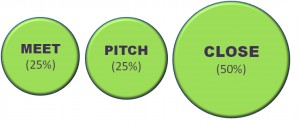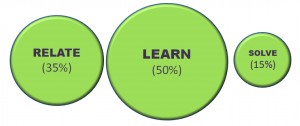Last week one of my close and respected sales professionals, Chris Conrey, released his manifesto entitled “Post Modern Sales.” I have read it several times over and found it simple, insightful, and on point. I am a huge fan of people who can get to point quickly and clearly without blathering all over the place and I admire this work for its efficiency and clarity.
I encourage you to take the time to read it and carefully assess your behaviors and sales process as it relates to the four shifts or transitions. It is the first transition that is the focus of this post: “Relationships and interactions over transactions.”
All too often I am still observing a sales behavior that emphasizes a ‘getting to the deal’ mindset. I recognize that depressed revenues and a shrinking market put increased pressure on making the most out of perceived business opportunities. However, there are still too many transactionally based behaviors that are actually inhibiting growth, rather than enhancing it.
 In the following graphic we see that most transactional relationships are still centered around: Meet, Pitch and Close. In this process around 50% of our time and energy is wasted on close tactics — negotiation, overcoming objections, sales manipulation, chasing after the prospect after we deliver our proposal. The inefficiency of this process is the amount of time spent chasing after a client to convince them to buy, rather than investing an appropriate amount of time learning and building a more impactful business relationship.
In the following graphic we see that most transactional relationships are still centered around: Meet, Pitch and Close. In this process around 50% of our time and energy is wasted on close tactics — negotiation, overcoming objections, sales manipulation, chasing after the prospect after we deliver our proposal. The inefficiency of this process is the amount of time spent chasing after a client to convince them to buy, rather than investing an appropriate amount of time learning and building a more impactful business relationship.
 The graphic to the left illustrates the differences is where the time is spent. In the Relate, Learn, Solve model, the selling time is a productive process of learning, discovery, and relationship building. By the time a solution is presented to a prospect their interest, their confidence, and their sense of value in the business relationship is quite strong; 0r significantly improving and shortening the close process. In this scenario little time is wasted chasing and all time is productively invested in building strong, lasting business relationships.
The graphic to the left illustrates the differences is where the time is spent. In the Relate, Learn, Solve model, the selling time is a productive process of learning, discovery, and relationship building. By the time a solution is presented to a prospect their interest, their confidence, and their sense of value in the business relationship is quite strong; 0r significantly improving and shortening the close process. In this scenario little time is wasted chasing and all time is productively invested in building strong, lasting business relationships.
I continue to press with this relationship model as I still hear and read a lot of the right noise regarding the concept; yet, I still have not observed enough professionals working the steps to do this effectively. The purpose of the graphics are designed to visually drive home the point where your time, energy, and focus needs to be if you are going to be a great relationship builder and professional resource for your clients. Hope this helps!

I experienced the relate, learn, solve model in a recent client contract. The purpose of the relate stage is to build trust; the client wanted to know what kind of person I am. Only after that extensive process did the client allow me to sign an NDA and tell me about his project. This was my opportunity to learn. I had to learn about his project and about whether I wanted to do business with him and to participate in the project. When both the relate and learn stages were fully-developed, the contract, a simple 2-page document, and the deposit, all took about 5 minutes. And the resulting project was a success!
Phil, what a great story. Thanks for sharing this. It is a great example of how your recognized the opportunities in the process. All the best to your continued success.
Hey Dave – Thanks for writing this down. Good to have it in black and white. I’m working on it!
Ps. I commented on you blog post because I liked it and found value in it. 🙂
Thank you for your comments and your feedback, Lindsay. I am happy to read that you are internalizing and using the tools.
I enjoyed reading this. The focus on learning about your client, and helping them solve their problem is a process that takes time and patience. Sometimes as you build relationships you may find you actually have common ground. Finding common ground is not always as easy as looking under your feet, but with practice, it does get easier. Thinking linear, forward and backward, may not lead to finding common ground. Two people standing at different elevations, won’t see eye to eye. Finding common ground takes some digging, or some reaching for higher consciousness depending on where you’re coming from. A trick I’ve learned is to deconstruct and rebuild what you’ve learned from another. If stupid is as stupid does, then smart isn’t as smart was. Addition and subtraction are the the same process. Multiplication and division are short cuts to adding and subtracting equal sets. The sets are common ground. How do our businesses compliment each other? Is it possible we have some common ground? If so, we can multiply our profits without much extra effort or money. If the road to hell is paved with good intentions, then the highway to heaven must be paved with bad intentions. So dig deep, don’t be afraid to ask burning questions. Finding common ground in the trenches will get you to your hopes and dreams faster than finding common blue sky above you.
Thank you for your comment and your excellent insights. I particularly appreciate the “deconstruct and rebuild what you’ve learned from another” perspective. Many times people don’t really learn enough to share that knowledge forward in other situations. Knowing how to repeat and share success is a critical component of productive selling activities.
How far do we need to swing the pendulum to change behavior, Dave? I have been stealing shamelessly from Brian Tracy for decades to shift from rapport, qualify, present, close to trust, needs, capability, commitment (where at least 70% is on trust and needs). Here you’ve raised the bar to 85% … will it be enough to get sales people to SHUT UP and LISTEN … or do we need muzzles? LOL!
Bill, thank you for your engagement and your question. With your permission, I am going to use this question as the foundation for my next blog and in my next conversation on the podcast series dontsellmebro.com. I have raised the bar on listening. The key is understanding and internalizin our role in sales as problem solvers. In order to solve the problem, we need to know what the problem really is — not what we want it to be or think it is. That is where it starts. See Tuesday’s post on 6/21.
Thanks for sharing your perspective. I hope more business professionals take time to listen and understand before suggesting solutions. Make it a great day!
Thanks for your comments and your participation.
Permission granted, Dave … with appreciation!
I stumbled upon your blog and this article and for me it has just reinforced the sales process for me as a Designer! My 5 step process is to Listen | Observe | Discover | Consult | Resolve.
Only once I have listened (that initial meeting and relating) I then progress to learning which for any designer is a reiterative process – the Solve and Resolve speak for themselves.
Thanks for sharing I shall now hook up with you across the various SM platforms. Keep the Fire Buring so you can keep on Cooking!
Kind regards
Julie
[…] wrote a blog post about The Relationship Model which drew a great comment from Bill M: How far do we need to swing the pendulum to change […]